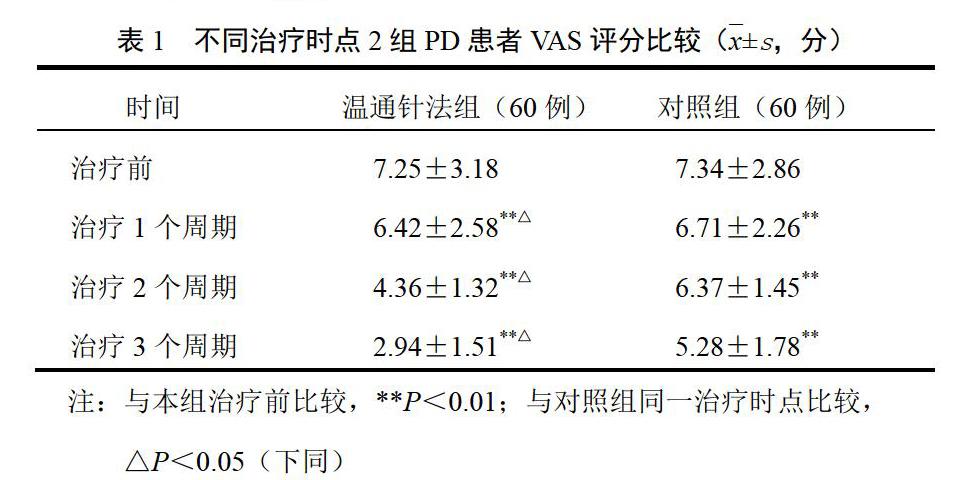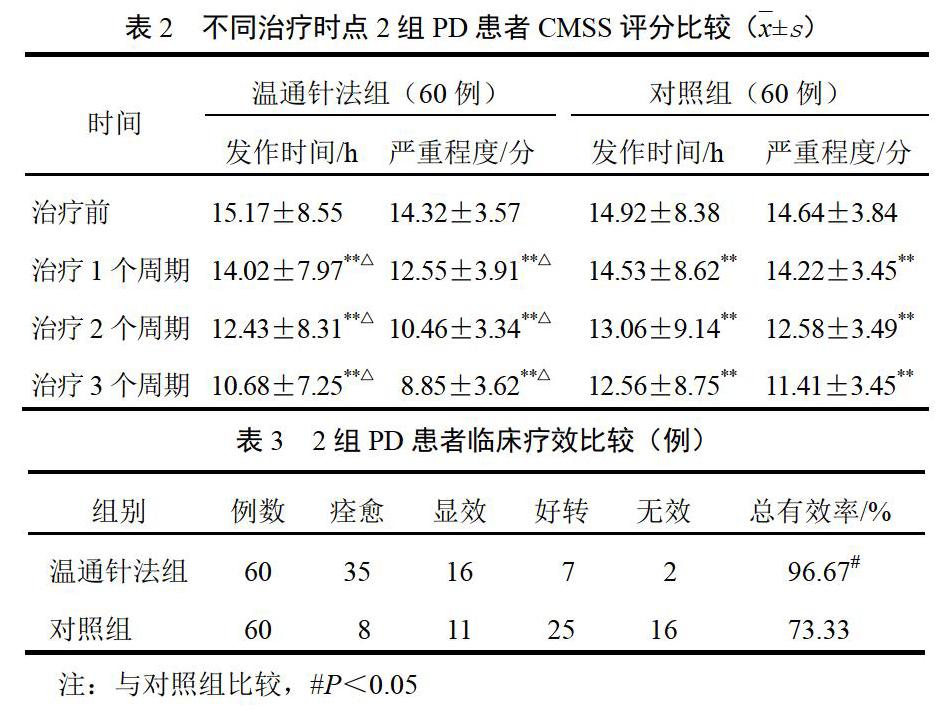温通针法治疗寒凝血瘀型原发性痛经随机对照研究
孙润洁 田亮 朱博雯 秦晓光


摘要:目的 观察温通针法治疗寒凝血瘀型原发性痛经的临床疗效。方法 将120例寒凝血瘀型原发性痛经患者随机分为温通针法组和对照组各60例。温通针法组取关元、三阴交、十七椎、地机施以温通针法,次髎、合谷、太冲运用平补平泻法;对照组选穴同温通针法组,运用平补平泻法。2组均于月经来潮前5~7 d开始治疗,每日1次,连续7次,疗程均为3个月经周期。采用视觉模拟评分法(VAS)和COX痛经症状量表(CMSS)评价治疗第1、2、3个月经周期末的疼痛程度,治疗结束后3个月随访评价临床疗效。结果 2组患者治疗后VAS和CMSS评分较治疗前明显下降(P<0.01),温通针法组VAS和CMSS评分明显低于同周期对照组(P<0.05)。温通针法组总有效率为96.67%(58/60),对照组为73.33%(44/60),差异有统计学意义(P<0.05)。结论 温通针法治疗寒凝血瘀型原发性痛经患者,能明显缓解痛经症状、缩短疼痛时间,具有肯定的临床疗效。
关键词:原发性痛经;寒凝血瘀;温通针法;视觉模拟评分法;COX痛经症状量表;随机对照试验
DOI:10.3969/j.issn.1005-5304.2016.01.005
中图分类号:R271.915 文献标识码:A 文章编号:1005-5304(2016)01-0023-04
Randomized Controlled Study on Warm-promotion Needling for Treatment of Cold Coagulation and Blood Stasis of Primary Dysmenorrhea SUN Run-jie, TIAN Liang, ZHU Bo-wen, QIN Xiao-guang (Gansu University of Chinese Medicine, Lanzhou 730000, China)
Abstract: Objective To observe clinical efficacy of warm-promotion needling for the treatment of cold coagulation and blood stasis of primary dysmenorrhea. Methods Totally 120 patients with cold coagulation and blood stasis of primary dysmenorrhea were randomly divided into warm-promotion needling group (60 cases) and control group (60 cases). Warm-promotion needling group was treated with warm-promotion needling at Guanyuan (RN4), Sanyinjiao (SP6), Shiqizhui (EX-B8), and Diji (SP8), and cooperated with Ciliao (BL32), Hegu (LI4), and Taichong (LR3). Control group took same acupoints and applied uniform reforcing-reducing method. The two groups began treatment 5-7 d before menstruation, 1 times a day, for 7 times. The treatment was given 3 menstrual cycles. The visual analogue scale (VAS) and COX menstrual symptom scale (CMSS) were used to observe the pain degree at the end of 1, 2, 3 menstrual cycles. The clinical efficacy was evaluated 3 months after treatment. Results The scores of VAS and CMSS was obviously reduced in the two groups after the treatment compared with those before treatment (P<0.01). The synperiodic scores of VAS and CMSS in warm-promotion needling group was obviously lower than those in the control group (P<0.05). The total effective rate of warm-promotion needling group was 96.67% (58/60), and the control group was 73.33% (44/60), the difference was significant (P<0.05). Conclusion Warm- promotion needling can obviously relieve dysmenorrhea symptoms and shorten the time of pain of patients with cold coagulation and blood stasis of primary dysmenorrhea, which has affirmative clinical efficacy.
Key words: primary dysmenorrhea; cold coagulation and blood stasis; warm-promotion needling; visual analogue scale; COX menstrual symptom scale; clinical efficacy; randomized controlled trial

